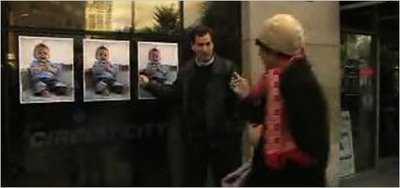
David Pogue's excellent adventure.
Posted by: EOLAKE STOBBLEHOUSE
Mike Comments: As several people have pointed out, both privately to me and in public comments, Mr. Pogue's trial, though interesting as far as it goes, doesn't appear to mean much. The best interpretation of his test methodology, which he's not entirely clear about, is that he's taken one 13-MP file and down-rezzed it to sizes equivalent to 8 and 5 MP, then made prints of the same size—hard to tell from the above, but they look to be somewhere on the order of 15" to 20" square, something in there.
The real issue is not just "5 MP is as good as 13 MP"; it's a good deal more subtle than that. As is fairly well known by now, a number of factors play a part in image quality and digital image enlargeability. Not only the size of the sensor and the pixel pitch (i.e., the size of each individual photosite), not only at what point and to what degree Bayer interpolation is applied and how the up-rezzing or down-rezzing is implemented, not only the size of the final print and the interaction between the printer's resolution and droplet size and that of the picture file, but even the subject matter...a picture of a baby, for instance, has a much lower demand for resolution than, say, a landscape with a lot of bare trees at infinity distance. As we know, when you up-rez digital files you lose detail, but—unlike the case with film—you maintain perfect smoothness in areas of broad color. It stands to reason, then, that pictures that depend on areas of broad color will fare better when up-rezzed than pictures that depend on fine detail.
As with film, all the determining factors tend to define not one predetermined, set "quality," but a range of possibilities, from "fine" to "not-so-good." And all those ranges overlap. Mr. Pogue's trial is one possibility; another might be to make broad-daylight pictures of the same subject with a 1/1.8" 5-MP sensor digicam, an APS-C 8-MP entry-level DSLR, and a full-frame 24x36mm 13-MP sensor Canon 5D, then make three prints from each: one 4x6", one 13x17", and one 40x60". And then perhaps do the same, but with pictures shot at 1600 ISO. With exponentially more visual data to evaluate, it might not be possible to get good survey results from passers-by on the street, but you'd see a bit more clearly what the ranges of possibility are from each sensor.
And, I would venture to guess, the fact that ordinary people couldn't readily tell the difference between the 4x6" broad-daylight prints from the 1/1.8" 5-MP sensor and the full-frame 13-MP sensor would not be quite enough to conclude that 5 MP is as good as 13 MP. Nor would it be entirely defensible to compare the 40x60" ISO-1600 prints and conclude that 13 MP is better than 5 MP for all people and all purposes!
Also, it's not wise to forget the hidden "equipment" each of us now uses that is just as important as the camera: our software, coupled with our abilities to use it. A skilled technician with inferior software might be able to make better prints than a newbie with Photoshop. Even "leveling the playing field" by giving all the files to an experienced technician to print wouldn't exactly be fair, because what owner of a 5-MP digicam would be using the exact same software and printer as a high-end DSLR photographer?
The upshot, I think, is that it's impossible to compare "just" megapixels and nothing else, because every possible way you could choose to conduct such a comparison subsumes several other choices and assumptions. And those choices and assumptions will determine, as much or more so than the simple megapixel count, the outcome of the test. —MJ
0 comments:
Post a Comment